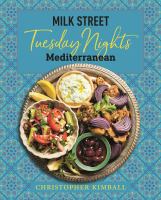
Bibliobites in March: Tepid Tuesdays
 Author and TV host Christopher Kimball and the cooks at his Milk Street empire are busy chefs indeed. In the past seven years they have published fifteen cookbooks, which has got to be some kind of record! Back in October 2021, out group reviewed Milk Street Cookish, a “quick and easy” title that delivered a fair number of hits, as well as some misses. This month we took on Milk Street Tuesday Nights Mediterranean, a 2021 title that revisits the “quick” (or is it “quickish”?) theme with a Mediterranean slant.
Author and TV host Christopher Kimball and the cooks at his Milk Street empire are busy chefs indeed. In the past seven years they have published fifteen cookbooks, which has got to be some kind of record! Back in October 2021, out group reviewed Milk Street Cookish, a “quick and easy” title that delivered a fair number of hits, as well as some misses. This month we took on Milk Street Tuesday Nights Mediterranean, a 2021 title that revisits the “quick” (or is it “quickish”?) theme with a Mediterranean slant.
To start with, our group wondered how author Kimball has managed to produce what amounts to an average of two full-length cookbooks per year. The answer was as obvious as the title page, which lists two writers and editors, three named cooks, and a group of unnamed “cooks at Milk Street.” Kimball is the author of record, but it’s unclear how much he’s involved in actual recipe development and testing. However he has a reputation for being very persnickety, and that was obvious in at least the design of the book. There are lush, detailed photos of every dish on the page facing the recipe. This made for an easy and very pleasant reading experience, as well as being useful during cooking. Even better, each recipe fit on one page, a marvelous feat that was also somehow accomplished without the font being excessively small. Well done! However, many in the group did not like how the recipes were arranged: the first three chapters are grouped by timing (fast-faster-fastest); subsequent chapters are by food type (salads, soups, vegetarian, and so on). It was an odd set of choices and made for lots of annoying flipping.
When we settled down to cooking (and there was lots of it!), the results were mixed. This is a title focused squarely on main dishes, so there were no snacks or desserts to distract us from our dinnertime quest. At our meeting, we sampled 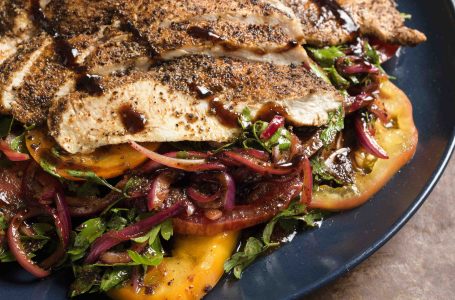 sumac-spiced chicken cutlets with tomato-onion salad. This tasty combination showcased smoked paprika and tart sumac; the tomato-onion salad provided freshness and crunch. This dish is good hot or cold and travels well, making it a solid choice for a potluck or picnic. We tried several other chicken dishes; chicken shawarma had “lots of spices to mix…I got a little frantic!” But all was forgiven since the “chicken was very tender, even when left over.” Traditional yogurt/tahini sauce was the perfect accompaniment. Another classic, chicken souvlaki with tzatziki turned out to be “a keeper….great combination, loved the tzatziki.” To keep things simple, the meat wasn’t skewered and grilled but simply broiled. Greek chicken and potato traybake was also “easy….really good.” Lemon, garlic, and kalamata olives hit all the right Mediterranean notes. Pan-roasted chicken and summer vegetables with herbes de provence saved a cook in a hurry. Ignoring all directions “I threw everything in the pot….it worked out beautifully!” Now that’s a keeper if ever there was one! There was one dud in the poultry patch: lombardy-style rice with chicken, a risotto-like dish, was “meh…bland.” The flavors were just a bit too subtle and didn’t come across in the finished dish.
sumac-spiced chicken cutlets with tomato-onion salad. This tasty combination showcased smoked paprika and tart sumac; the tomato-onion salad provided freshness and crunch. This dish is good hot or cold and travels well, making it a solid choice for a potluck or picnic. We tried several other chicken dishes; chicken shawarma had “lots of spices to mix…I got a little frantic!” But all was forgiven since the “chicken was very tender, even when left over.” Traditional yogurt/tahini sauce was the perfect accompaniment. Another classic, chicken souvlaki with tzatziki turned out to be “a keeper….great combination, loved the tzatziki.” To keep things simple, the meat wasn’t skewered and grilled but simply broiled. Greek chicken and potato traybake was also “easy….really good.” Lemon, garlic, and kalamata olives hit all the right Mediterranean notes. Pan-roasted chicken and summer vegetables with herbes de provence saved a cook in a hurry. Ignoring all directions “I threw everything in the pot….it worked out beautifully!” Now that’s a keeper if ever there was one! There was one dud in the poultry patch: lombardy-style rice with chicken, a risotto-like dish, was “meh…bland.” The flavors were just a bit too subtle and didn’t come across in the finished dish.
Quick-cooking shrimp got a workout in this book; two people made shrimp with orzo, tomatoes, and feta. This version of the classic was “really fast….really easy….flavors melded well!” Venetian-style shrimp in tomato-white wine sauce also featured tomatoes in a spicy sauce; the result was “really good” and was predictably quick to make. 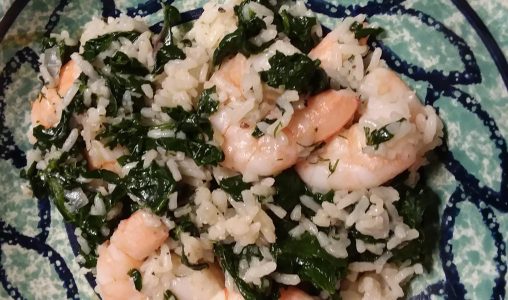 Greek-style spinach rice with shrimp and dill turned a side into a main dish with the addition of shrimp, which was gently steamed atop the cooked rice and spinach. Lemon and dill played nicely together with the spinach; it aged well, too. Two cooks tried spanish shrimp and chickpea stew. Though butterflying the cooked shrimp (as directed) proved messy and tricky, the result was “delicious!” Or “meh,” if you’re a cook who’s not very fond of smoked paprika, a prominent flavor in the stew. Unfortunately, spanish scrambled eggs with shrimp and asparagus was a thumbs-down; “the flavors were just OK….it didn’t come together….I won’t make again.”
Greek-style spinach rice with shrimp and dill turned a side into a main dish with the addition of shrimp, which was gently steamed atop the cooked rice and spinach. Lemon and dill played nicely together with the spinach; it aged well, too. Two cooks tried spanish shrimp and chickpea stew. Though butterflying the cooked shrimp (as directed) proved messy and tricky, the result was “delicious!” Or “meh,” if you’re a cook who’s not very fond of smoked paprika, a prominent flavor in the stew. Unfortunately, spanish scrambled eggs with shrimp and asparagus was a thumbs-down; “the flavors were just OK….it didn’t come together….I won’t make again.”
Another favorite for speedy meals, pasta, also made several appearances. Crispy pasta with chickpeas, lemon, and parsley was quite a twist on your standard boiled noodles: half of the uncooked fresh pasta was fried until crisp, and then added to the rest of the ingredients (including the cooked portion of the pasta) at the end. This was “kind of strange….the pasta wasn’t crispy [by the time the dish was complete].” Also, it “took a lot longer than [the stated] 35 minutes.” One saving grace: “better the second day….flavors developed.” Much more traditional, fettucine with mushroom and tomato ragu was unfortunately “disappointing….tasteless.” Despite lots of mushrooms and fresh rosemary, the flavors just didn’t come through. On the opposite side, 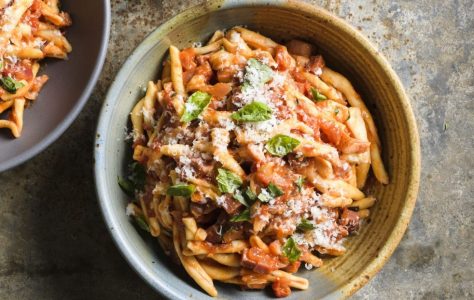 penne alla silana, although a bit on the pricey side with its plentiful salami and cheese, was enjoyably loaded with salty and spicy flavors. Pasta with tomatoes, orange, and olives featured a combination that is common in Sicily but unusual to us; and our cook ultimately did not like this marriage of fruity and salty. Another unfamiliar combination fared a bit better; rigatoni with pistachio, ricotta and herb pesto suffered from a lack of fresh basil (not very available at this time of year), but “we did eat it!” Worth trying again in the summer?
penne alla silana, although a bit on the pricey side with its plentiful salami and cheese, was enjoyably loaded with salty and spicy flavors. Pasta with tomatoes, orange, and olives featured a combination that is common in Sicily but unusual to us; and our cook ultimately did not like this marriage of fruity and salty. Another unfamiliar combination fared a bit better; rigatoni with pistachio, ricotta and herb pesto suffered from a lack of fresh basil (not very available at this time of year), but “we did eat it!” Worth trying again in the summer?
Vegetarians had plenty of choices in this book; there’s even a dedicated “hearty vegetarian” chapter.
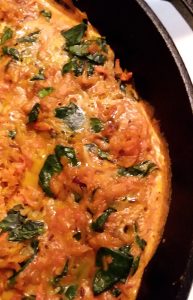
Eggah was a fluffy, tender variation on a frittata. This version was filled with grated sweet potato and carrot, onion, and spinach. For one cook it was just OK, but for another it was a definite keeper, “quick…savory…loved the texture!” Greek baked vegetables were another keeper; layered potatoes, zucchini, and tomatoes were roasted and topped with savory, salty feta. The classic flavors worked together beautifully for a delicious result. Roasted butternut squash with chickpeas, herbs, and tahini was “a bit of work” to put together, but the resulting dish was “very flavorful!” Chickpeas and tahini sauce turned roasted squash into a filling, yet not heavy, main dish. Another dish featuring butternut squash, turkish-style stuffed flatbreads with butternut squash and cheese was also a hit; mashed squash, halloumi cheese, and warm spices were rolled into flour tortillas and then shallow -fried until crispy. Yogurt/olive oil sauce provided a cooling contrast, “just a yummy combination!” Three people tried out
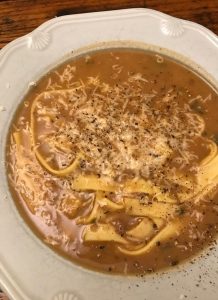 italian bean soup with fresh pasta. For two cooks it was a keeper; this very simple combination of beans, rosemary, and pasta just hit the spot. For the third cook, it may have been just a bit too simple; it was deemed “OK.” Perhaps in an attempt to keep things quick and easy, the recipe instructed you to use fresh pasta and cook it in the pureed soup. Though it’s another step, we thought it would ultimately be simpler to cook dried pasta separately and then add it to the bowls when served. A couple of lentil dishes didn’t quite make the grade: lemony lentil-kale soup with sweet potatoes had “lots of chopping,” and was “a bit too lemony…OK….wouldn’t make again.” As is often the case with lentils, the finished soup was “visually unappealing.” Poor lentils! Lentils and bulgur with fried onions (mujaddara), a popular comfort food across the Middle East, did not turn out as expected; it was “so dry….I won’t make again.” Other group members mentioned that they had made other versions of this dish and thought it was excellent, so perhaps this particular recipe isn’t the one to go with! We only made one salad, but it was a keeper: bulgur salad with summer vegetables and pomegranate molasses was “absolutely delicious!” It went to a potluck where it disappeared quickly. Pomegranate molasses added addictive fruity tartness to the dressing.
italian bean soup with fresh pasta. For two cooks it was a keeper; this very simple combination of beans, rosemary, and pasta just hit the spot. For the third cook, it may have been just a bit too simple; it was deemed “OK.” Perhaps in an attempt to keep things quick and easy, the recipe instructed you to use fresh pasta and cook it in the pureed soup. Though it’s another step, we thought it would ultimately be simpler to cook dried pasta separately and then add it to the bowls when served. A couple of lentil dishes didn’t quite make the grade: lemony lentil-kale soup with sweet potatoes had “lots of chopping,” and was “a bit too lemony…OK….wouldn’t make again.” As is often the case with lentils, the finished soup was “visually unappealing.” Poor lentils! Lentils and bulgur with fried onions (mujaddara), a popular comfort food across the Middle East, did not turn out as expected; it was “so dry….I won’t make again.” Other group members mentioned that they had made other versions of this dish and thought it was excellent, so perhaps this particular recipe isn’t the one to go with! We only made one salad, but it was a keeper: bulgur salad with summer vegetables and pomegranate molasses was “absolutely delicious!” It went to a potluck where it disappeared quickly. Pomegranate molasses added addictive fruity tartness to the dressing.
There were a few meaty doings, as well. Four people made 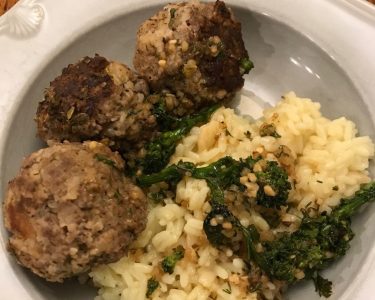 beef and rice meatballs with lemon-olive oil sauce. All agreed that these oversize meatballs were delicious; the accompanying sauce was deemed “the best part.” This recipe took much longer to put together than its timing indicated; mashing the cooked rice as directed proved unexpectedly tedious and time-consuming. Greek meatballs in tomato sauce were also a good choice, with a slightly spicy sauce spiked with cinnamon. They reheated well, too. Pan-roasted pork tenderloins with apple, sherry, and smoked paprika were deemed “very very tasty!” Apples and pork are a classic combination for good reason, while sherry and smoked paprika added a bit of Spanish flair.
beef and rice meatballs with lemon-olive oil sauce. All agreed that these oversize meatballs were delicious; the accompanying sauce was deemed “the best part.” This recipe took much longer to put together than its timing indicated; mashing the cooked rice as directed proved unexpectedly tedious and time-consuming. Greek meatballs in tomato sauce were also a good choice, with a slightly spicy sauce spiked with cinnamon. They reheated well, too. Pan-roasted pork tenderloins with apple, sherry, and smoked paprika were deemed “very very tasty!” Apples and pork are a classic combination for good reason, while sherry and smoked paprika added a bit of Spanish flair.
Friends, I think it’s obvious by now that we gave this book a thorough going-over. We cooked our way through over 30 unique recipes, about 25% of the book’s total! Generally, we thought this title was a solid introduction to signature Mediterranean foods and seasonings. It may not be perfectly authentic, but it’s close enough to (literally) give you the flavor of this broad area. Though we did not appreciate the book’s arrangement, once we were done flipping back and forth most of us found a keeper or two, or a new spice or condiment to wake up our taste buds (I’m looking at you, pomegranate molasses!). Still, no one was rushing out to buy this book, and our ratings were on the tepid side: we averaged out to a 3.4 (out of a possible 5).
Please join us for our next meeting on Friday, April 26 at 11 AM in the Fireplace Room. We’ll be discussing The Golden Spoon, a thriller/mystery that’s set at a baking competition, by Jessa Maxwell. Murder, she baked? Speaking of baking, if you want to bake as well as read, you can also check out a British Baking Show title; all titles available at the main circulation desk or via curbside pickup.






